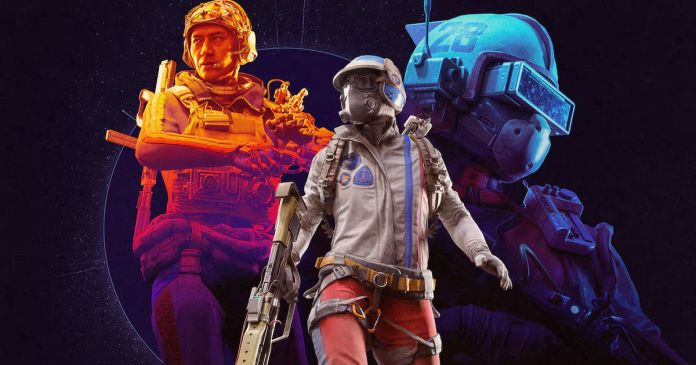Rich PvE combat and an unusually friendly community make Arc Raiders a more approachable extraction shooter than most, but Embark Studios’ continued use of AI voice generation is a black mark against its reputation.
Arc Raiders is notionally about humans battling to the death over scraps on a blasted Earth ruled by robots. But it’s really about risking your virtual life for some apricots to satisfy the world’s most demanding chicken. It was on one such poultry-induced shopping expedition when I encountered three men cresting a rise over a sand dune, bristling with weapons.
Outnumbered and exposed, I resigned myself to death. Yet the response was not a hail of bullets, but an American mumble of “Hey dude” that immediately deflated the tension. As the trio trudged by, the rearmost of them jovially added “We’re looking for lemons!” – another fruit craved by our mutual, fowl master.
Such encounters are at the heart of what has made Arc Raiders the biggest game of the autumn – a cultural phenomenon defined by its phenomenal culture. In this ruined world where everyone is out to smash and grab whatever they can, you will regularly witness organic displays of deescalation, armistice, and even jolly cooperation.
Arc Raiders is not the first game to do this; displays of human decency have been a feature of survivalist shooters since DayZ. But it is the first in a long time to bring our better angels to the fore, and is perhaps the game where such behaviour is most prevalent. Indeed, Arc Raiders has reached the point where friendly players have begun shaming hostile players for having the audacity to play the game as designed, which is remarkable, if misguided.
How did this happen? Some of it may be ascribed to chance, with Embark Studios possibly benefitting from a broader shift toward cooperative games over the last few years. There’s also a degree of relativity, with solo players tending to be friendlier than groups. But it is also, inescapably, part of Arc Raiders’ design.
Structurally, Arc Raiders is a typical extraction shooter, with teams ranging from solos to trios spawning dispersed across large maps, aiming to stuff their backpacks with goodies then escape to the subterranean city of Speranza via underground elevators, subway stations, and air shafts. Those goodies are used to craft and/or buy superior weapons and equipment, before the whole rigmarole begins again.
Throughout your half-hour bouts on the surface, the air thrums with the potential for violence. This is partly due to the presence of other players but primarily it’s from the titular Arcs. These robots come in various shapes and sizes, ranging from gun-toting drones to colossal mechanical spiders. But they are all dangerous, with even the smallest capable of killing careless raiders in a matter of seconds.
They are also quite brilliantly designed, both individually and collectively. The Wasps and Hornets that form the bulk of the Arc forces fly in the face of received wisdom that floating enemies are not fun to fight, their deceptive durability, carefully telegraphed attacks, and tendency to spin out of control when shot making each encounter a thrillingly deadly dance. Then there are the rolling balls that lurk inside buildings, acting as mobile traps by exploding or spitting flame. These mechanical jumpscares make interior exploration fraught with peril, not least because you know that about half the map just heard them explode.
Indeed, it’s the Arcs’ combined power that makes them so dangerous. Any noise can potentially attract an Arc’s attention. Gunfire, activating an extraction point, even a heavy fall can ignite the curiosity of a patrolling wasp. Some Arcs are specifically designed to bring additional pain to your doors. Seeing the searchlight of a bucket-shaped Snitch turn red always triggers a frantic scramble to bring it down before it can call in reinforcements.
The Arcs’ presence makes taking on other players an additional risk that must be calculated carefully. On top of that, some of the larger Arcs, the leapers, bastions and the almighty Queen, are difficult to take down without extra help. In this manner, cooperation is tacitly encouraged, further facilitated by Arc Raiders’ most famous voice command: “Don’t Shoot!”. This easily deployable icebreaker enables the most voice-chat averse players to defuse an encounter and possibly even strike up an allegiance.
Such is the way in which Arc Raiders encourages a more affable extraction experience. But I cannot stress enough that this surprisingly genial atmosphere would be nothing without the bastards. Every player willing to shoot you in the back, to snipe you from afar, to booby trap an extraction point, is as vital to the game’s ecosystem as the friendlies, even if I will curse their names to the end of time as they stand over my prostrate form preparing to sock me back to Speranza. Without them, there would be no magic to those moments when a player capable of killing you chooses not to.
Even when fighting breaks out among players, Arc Raiders remains friendlier than most extraction shooters. The wide-angle view afforded by third-person makes it harder for enemy players to ambush you, while the energy shield all Raiders carry often prevents instant kills, generally giving you a chance to respond. Combat broadly feels very deliberate, with slow weapon reloads, health replenishment, and no deployable hotkey emphasising more thoughtful encounters.
Arc Raiders is also adept at involving you in its loot cycle, making everything you pick up feel valuable and part of a larger plan. The crafting system, where you must build and upgrade workbenches in order to create higher-tier gear, will have you sniffing out hyper-obscure items ranging from antiseptic to toasters. Meanwhile, the missions dispensed by traders won’t win any narrative or design awards, but they are good at introducing you to loot locations across the shooter’s vast, evocative maps. Objectives could be better signposted, however, so you don’t spend ages looking for a crate the size of a shoebox in a junkyard.
And while there will be dizzying highs and frustrating lows in Arc Raider’s rollercoaster of gear acquisition, it always ensures you can go into a fight with something. A randomised free loadout is always available for those running low on weapons, resources or cash—or who just want to do a quick run without risking their best stuff. And then of course, there is Scrappy, the bizarrely lovable cockerel who generates basic crafting resources over time, whose scavenging can be improved by sourcing eclectic items like dog collars, cat beds, and, naturally, apricots.
Like Embark’s previous shooter, The Finals, Arc Raiders displays considered design. Also like The Finals, this design is overshadowed by the spectre of AI. Arc Raiders uses machine-learning algorithms for its Arc animations, and text-to-speech-based performances generated from the voices of real actors.
While I am deeply sceptical of AI use in game development, it’s important to emphasise the nuances at play here. For starters, these two techniques are not the same, while Embark has further argued (less convincingly) that TTS is different from generative AI tools like ChatGPT.
Certainly, machine learning is not a new technology in video games, experimented with by developers at least since the Black & White days. The animations of the Arcs – how they adapt to environments and react to being shot – are based on similar principles to Black & White’s Creature AI. Embark has attempted to create emergent behaviours in its enemies through reinforcement learning, enabling them to both move and react to terrain and player-behaviour in highly realistic ways. It’s an interesting technology, and the effects it produces during matches are undeniably convincing.
The same cannot be said about Embark’s generated voice lines, which are aggressively mediocre and a stain on the experience. While speaking characters are mostly limited to traders (though player characters also vocalise emotes and pings during matches) when you do speak with them their voices are flat and emotionally blunted, aside from the occasional bizarre inflection that reveals their robotic roots. It’s telling that the sole memorable character in Arc Raiders is a rooster incapable of speech.
Embark claims it uses AI voices so the studio can implement ideas quicker, creating new voice lines in hours rather than having to go through the longer process of manual rerecording (and therefore re-hiring actors). But NPC voices are not central to the experience, so I don’t think this argument holds water. Even if it did, Arc Raiders’ launch has been so successful Embark could probably hire a team of live-in voice actors and still make gargantuan amounts of profit, while benefitting from more memorable characters as a result.
At the same time, is Embark’s use of AI voices sufficient to compromise the game, given they are only a small part of the experience? I mulled over this for a while, and the more I thought about it, the angrier I became. Because yes, using AI voices does compromise Arc Raiders, not just ethically, but artistically too.
Let’s start with the obvious point, that Arc Raiders is set in a world where humanity has been driven underground by a race of hostile robots. The contradiction here between Arc Raiders’ themes and the manner of its creation is so glaring that it makes me want to scream. You made a game about the tragedy of humans being replaced by robots while replacing humans with robots, Embark! It displays a total lack of awareness, or worse, wilful ignorance of Arc Raiders’ own semantics.
But what really bakes my noodle is that so much of what makes Arc Raiders compelling in the first place derives from human voices. That guy I mentioned at the outset, Mr Looking for Lemons? It wasn’t just what he said that stuck with me, it was the way he said it, irrepressibly cheerful and endearingly goofy, with all the Rs and Ls drawn out. It was as distinctive and memorable as the way Matt Berry says “New York Citaaaaay!” in What We Do in the Shadows. In fact, I tried to think of an actor I could compare it to, but failed because nobody else would have said it like that.
Arc Raiders has facilitated millions of similar interactions since launch, but that only makes Embark’s use of AI voices more abhorrent. For Arc Raiders to ride the wave of human sociability all the way to the bank, while also being so contemptuous of the thing that makes us social animals in its own workflow – carving up human voices and reassembling them like a digital Victor Frankenstein – demonstrates a lack of artistic integrity that I find impossible to ignore. However smartly designed Arc Raiders is, I cannot recommend it, because Embark does not value the thing that makes it special.
A copy of Arc Raiders was provided for this review by Embark Studios.








